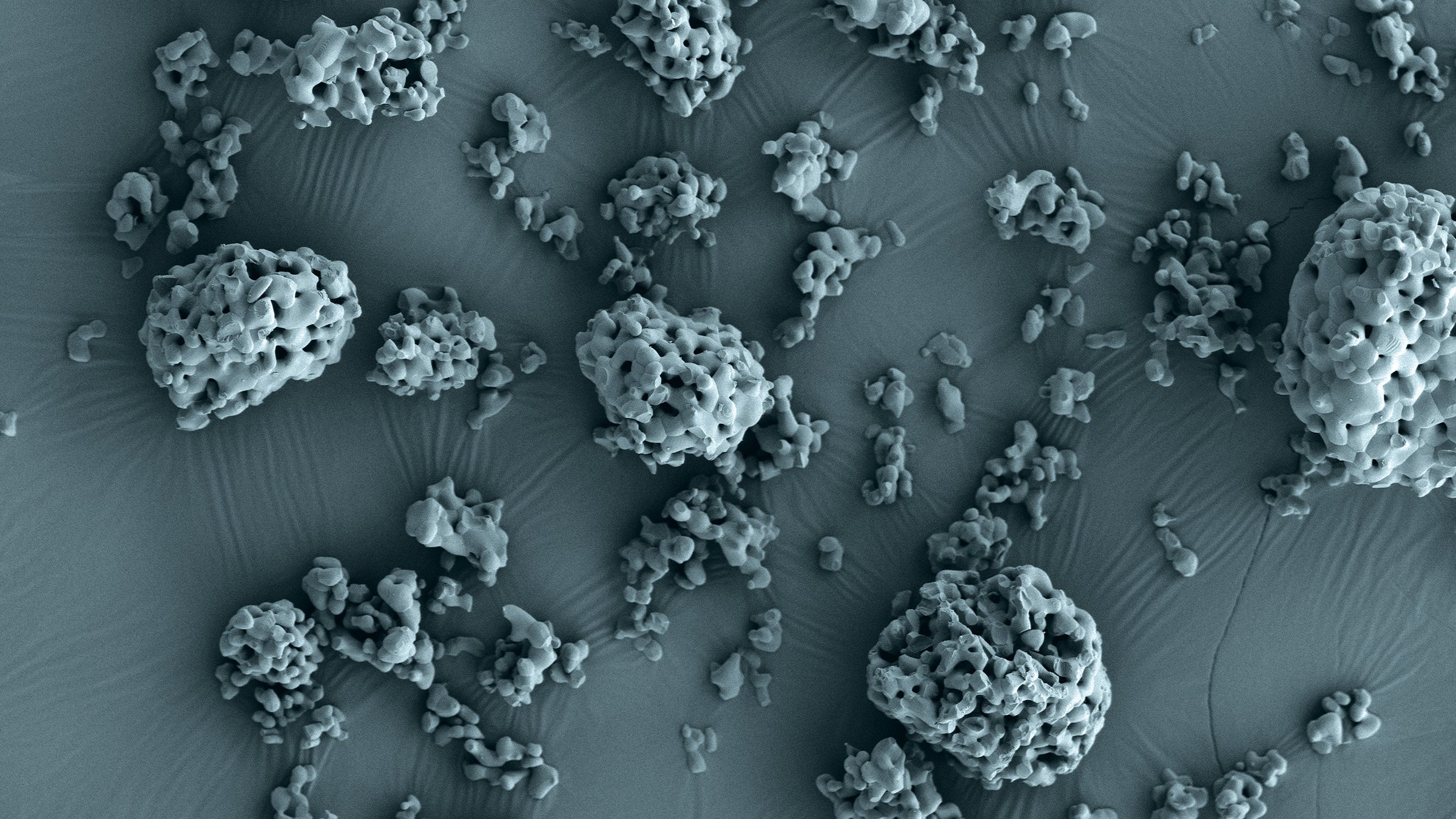
Beta-tricalcium phosphate
Bioactive β-TCP Powders & Granules for Hard Tissue Applications
Beta-tricalcium phosphate (β-TCP) is a bioactive, resorbable calcium phosphate compound widely used in bone grafting and implant applications. Due to its osteoconductive properties, β-TCP supports bone regeneration by acting as a scaffold material that gradually resorbs, thereby allowing natural bone to replace it over time. This resorption rate can be fine-tuned by changing physical characteristics such as porosity and particle size.
Additionally, β-TCP integrates well with other biomaterials, including other calcium phosphates such as hydroxyapatite, or polymers like poly(lactic-co-glycolic acid) (PLGA)—broadening its mechanical and resorption properties for diverse orthopedic, dental, and craniofacial applications.
Material Properties of β-TCP and Their Impact on Bone Repair
Beta-tricalcium phosphate owes its biocompatibility to a chemical composition that closely resembles natural bone mineral. This similarity allows β-TCP to integrate readily with surrounding bone tissue, promoting cell proliferation and hard tissue adhesion without provoking adverse immune responses.
XRD analysis of a solid state sintered form of beta-tricalcium phosphate (Himed Catalog Code #SSBTCP) with a composition of ≥96% β-TCP.
β-TCP is also highly osteoconductive—and can be fabricated into a porous scaffold that facilitates the attachment and growth of bone cells, or osteoblasts. A porous structure allows cells to infiltrate, adhere, and expand within the material, guiding new bone formation along its surface. This osteoconductive quality makes β-TCP invaluable in applications like bone grafting, spinal fusion, and dental implants, where integration with existing bone is critical.
Beyond supporting surface bone cell growth, β-TCP offers osteoinductive properties that enable it to encourage the differentiation of progenitor cells into bone-forming cells. Consequently, β-TCP can stimulate bone growth even in areas where native bone tissue is currently deficient.
Perhaps more than any other factor, it is resorbability that sets β-TCP apart from permanent implant materials like titanium, metal-alloys, and polymers such as polyetheretherketone (PEEK). As it gradually degrades, β-TCP is replaced by natural bone tissue, supporting the healing process without the need for additional surgeries to remove the implant material.
Together, these properties—biocompatibility, osteoconduction, osteoinduction, and resorbability—make β-TCP an exceptional material for bone repair. It not only provides the scaffolding support needed for healing but also actively promotes regenerative outcomes.
Applications of β-TCP in Medical Products
Spinal Fusion Cages
Dental Implants
Oral and Maxillofacial Surgery
Fracture Fixation
Trauma Implants
Injectable Fillers
Osteochondral Defect Repairs
Targeted Drug Delivery Systems
Customizing β-TCP to Enhance Bone Growth
While β-TCP is inherently osteoconductive and osteoinductive, its effectiveness in promoting bone growth can be further enhanced through specific customizations. These modifications allow β-TCP to meet precise clinical needs, optimizing its performance across different applications:
Porosity
The porosity of β-TCP can be carefully tailored during manufacture to support greater cell infiltration, neovascularization, protein adsorption, and nutrient exchange—factors essential for sustained bone development. By modifying pore size, interconnectivity, and distribution, β-TCP can be optimized to create an ideal scaffold for osteoblast activity.
Particle Size
Particle size not only impacts resorbability rates, it also plays a significant role in supporting the functional application of the final product. For example, larger granules are more appropriate for bone fillers, whereas fine powders are generally better suited for mixing into injectable pastes.
Himed produces various forms of β-TCP with particle size ranges from <5 μm to 1000 μm — a complete listing of particle sizes is available via our catalog.
Surface Texture Modifications
Altering the surface texture of β-TCP improves cellular attachment and proliferation. Surface modifications can increase the overall area available for cell adhesion as well as improve cellular attachment, which enhances bioactivity and accelerates osseointegration.
Himed manufactures beta-tricalcium phosphate powders formed through either precipitation and sintering (left) or through a solid-state sintering process (right). As the SEM images demonstrate, the method of manufacture produces significantly different surface topographies, with the precipitated and sintered SWBTCP generally being more bioactive due to its greater surface area.
Controlled Resorption Rates
Through adjustments in particle composition and density the resorption rate of β-TCP can be engineered to degrade more slowly or more quickly, depending on the required application. A controlled resorption rate helps ensure that the β-TCP remains supportive to new bone as it develops.
Incorporation of Osteogenic Agents
β-TCP can be combined with osteogenic agents, such as bone morphogenetic proteins (BMPs) or other growth factors, to enhance its osteoinductive properties. By incorporating these agents into β-TCP scaffolds or coatings, the material can actively stimulate bone cell differentiation and proliferation, resulting in faster and more effective bone regeneration. This customization is especially beneficial in applications like trauma repair, reconstructive surgery, or spinal fusion procedures, all of which require rapid integration.
Metal Ion Doping
Numerous studies have emerged recently that explore how adding metal ions like magnesium (Mg), strontium (Sr), zinc (Zn), and copper (Cu) to β-TCP can further enhance its osteoinductive properties. Magnesium and strontium ions, for instance, improve osteogenesis and angiogenesis, promoting cell viability, proliferation, and osteoblastic differentiation to support in vivo bone regeneration; while zinc and copper ions are of interest due to their natural antibacterial properties.
Composite Blending with Other Biomaterials
For applications that require a blend of mechanical strength and bioactivity, β-TCP can be integrated with other materials such as polymers, bioactive glass, or even metals. For example, β-TCP can be combined with polyetheretherketone (PEEK) to create a composite with mechanical properties similar to bone, while still retaining osteoconductive properties. These composites are particularly useful in load-bearing implants, where both durability and bioactivity are essential for long-term success.
By customizing β-TCP in these ways, it’s possible to create highly specialized bone grafts, scaffolds, and coatings that maximize osteoconduction, improve biocompatibility, and accelerate healing.

Curious Whether β-TCP Could Enhance Your Medical Device Design?
If you’d like support with identifying the potentials beta-tricalcium phosphate might offer a medical device design you’re developing, feel free to contact us. We’re happy to have exploratory conversations and share bioceramic insights that might support you in your goals.
Sample of precipitated and sintered b-TCP with a size range of <53 μm (Himed Catalog Code #SWBTCP20).



